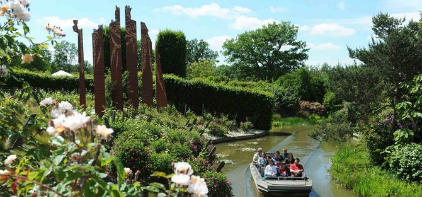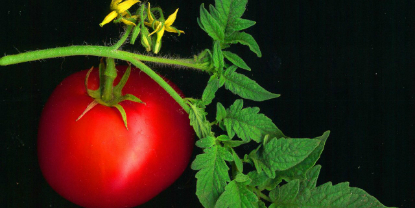After surviving one of the coldest and driest Januarys that I can
remember, my thoughts are turning to the upcoming spring season,
and in particular to America's favorite backyard vegetable, the
tomato.
To be successful, gardeners need to choose the right tomato for
their needs, plant it at the right time of year, and put it in the right
kind of soil.
What to plant: There are hundreds of tomato varieties to choose
from. Heirlooms or hybrids? Determinate or indeterminate growth
types? Cherries or beefsteak sandwich size? Quantity versus quality?
Let's start by defining some tomato terms. (It can get confusing!)
Heirloom tomatoes are strains that have been reproduced for gen-
erations without cross-breeding. Hybrids, on the other hand, are a
cross between two different varieties.
Most gardeners believe that heirlooms taste the best. Almost all
heirlooms are indeterminate vining types that grow and bloom
from spring to fall.
This may sound appealing from a production standpoint, but our
central Texas summers with 95 degrees plus days and 75 degree
nights keep these large fruited varieties from setting. This means
production from June through the first half of September is limited.
Some flavorful heirloom varieties to look for are Cherokee Purple,
Brandywine, Green Copia, Bumble Bee, Arkansas Traveler, Black
Krim, Mister Stripey, Pink Berkeley Tie Dye, and Paul Robeson.
I’ll have to admit, Cherokee Purple is the best tasting tomato that
I have ever eaten.
On the quantity side you have hybrid crosses that are determinate
varieties that grow fast and produce lots of flowers and fruits be-
fore heat sets in. All hybrids have effective disease prevention built
into their genetics. Hybrids are not GMO. They are selected crosses
from parents that have desirable traits.
Some of the best and most productive hybrids are the past and pre-
sent Rodeo tomatoes. Every year the best new tomato hybrid for
Central Texas is released at the San Antonio Stock Show and
Rodeo in mid-February.
This year's Rodeo winner is called Sunbrite. This delicious tomato
is a reliable, large-fruited, beefsteak slicer with the potential for
producing upwards of 25 pounds of high quality fruit.
Past Rodeo varieties to look for are BHN 602, BHN 444, Valley
cat, Bobcat, Red Deuce, Tycoon, and HM 1823.
Last spring’s planting of BHN 602 produced an astonishing
61.5 pounds of fruit, while HM 1823 averaged over 15 pounds.
When to plant: This is very important. Getting them out early
before heat sets in is critical. Most folks wait till mid-March,
when the average freeze and frost is behind us.
Sam Lemming of Buda, the most successful tomato grower I
know, plants his transplants early to mid-February and covers
them when there are frosts and freezes. He manages to get tons
of fruit to set before the heat of mid-May sets in. (By the way,
Sam’s favorite all time tomato is Celebrity. Shhh! Trade secret!)
Where to plant: a sunny, well-drained location is super-import-
ant. Your plants will require six to seven hours of direct sun at
a minimum. Also, to get a bumper crop, you will need to mix
in tons of organic soil conditioner and compost. Our favorite is
Happy Frog Soil Conditioner, which comes with earth worm
castings, bat guano, beneficial bacteria and mycorrhizae.
If you mix this soil conditioner into your vegetable bed with add-
ed dried or liquid molasses, you will then activate the soil microbes.
Don’t forget to add some organic slow-release fertilizer to help
sustain growth. Our garden sages David and Dwight favor Lady-
bug 8-2-4 and Happy Frog Tomato and Vegetable blend 7-4-5.
Also add some dolomite lime to the soil to keep calcium levels
high. This will protect your fruit from the dreaded blossom end rot.
Whatever route you choose, I hope this will be your best tomato
spring ever. Happy gardening everyone!






